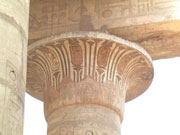TOUR NEWS - MALTA AND SICILY JANUARY 2013
After spending Christmas in the UK, Ian Casey and I headed to Malta on the 2nd January 2013. The rest of the month was spent exploring the touring opportunities on Malta and Sicily in preparation for the upcoming B.C. Archaeology Tour in March-April 2014. We landed in Valetta after just a few hours flight from London (if only we could get there as quickly from Sydney!). We stayed in the Palace Hotel in the district of Sliema, an old quarter of Valetta across the harbour from the Old City. We had a rental car which made life much easier.
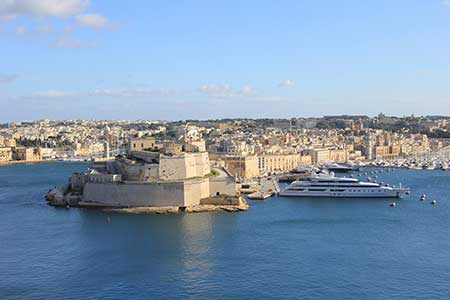 |
 |
The walls of Fort St Angelo in Valetta |
The ruins of Hagar Qim |
The following day we went by ferry across Marsamsett Harbour � the approach to the 16th Century walls of Valetta (built by the Knights of St John) is very dramatic with the old city rising up in front of you. We walked up through the city (well laid out in the grid pattern in the aftermath of the Ottoman attack on Malta in 1565) to the Upper Barakka Gardens where there is a superb view across Grand Harbour. We explored the land walls of Valetta and also descended into the moat via a wonderful modern glass elevator. From here we went to St John�s Co-Cathedral, the lavishly decorated 16th Century church of the Knights � the floor, covered with inlaid marble tombs of the Knights, is remarkable. We also saw the Grand Master�s Palace with its State Rooms and Armoury.
The following day we drove to the south coast to see some of the most ancient sites of the island � we visited the Ghar Dalam Cave where palaeontologists have recovered the remains of pigmy elephant and hippos (smaller than a man) which lived in the area from 150,000 � 18,000 years ago. The local museum displays some of the finds. From here we went to see the megalithic temples of Mnajara and Hagar Qim. These remarkable buildings were built between 3600-3000 BC and consist of multi-roomed cult places built of colossal limestone blocks. The two temples are now roofed to protect the remains from the elements. The local museum displays finds from the excavations � considering the antiquity of the two temples, the scale of them is impressive.
The next day we drove to see the fortified hill town of Mdina in the centre of Malta. This is a very ancient town going back to Phoenician times and the mediaeval walls are most impressive. We saw the Roman 'Catacombs of St Paul' which can be explored for many hundreds of metres and include numerous chambers for burials. They date from the 3rd Century onwards. We then visited the nearby Museum of Roman Antiquities � this is actually built over the ruins of an ancient roman villa which still retains its floor mosaics. The collection includes beautiful examples of roman glass, sculpture, pottery and objects of daily life from across the island. We then walked across the moat into the old city, where we saw the Cathedral of St Paul and enjoyed the viewpoint from which much of the island can be seen.
On the 5th January 2013 we explored more of Valetta � we caught the ferry over to the old city and then walked around the walls, passing underneath the enormous bastions of Fort St Elmo. The views across Grand Harbour are impressive. We visited the national war museum and saw the VC which was awarded to the population of Malta during WWII. We also walked up through the old city again and had another visit to the Grand Master�s Palace where we saw the elaborate state rooms� after lunch in a wonderful caf� called the Caf� Royale, we spent the afternoon in the National Archaeological Museum. This has an extensive collection of remains from the temple building phase, and some newly restored rooms looking at the Phoenician remains from the island.
 |
 |
The Co-Cathedral of St John in Valetta |
The theatre of Syracuse |
The next day we explored the district known as Vittoriosa (also called Birgu), the early 16th Century home of the Knights of St John before they established Valetta proper. The land walls of the city are remarkably well fortified - we crossed the moat and went into the walled peninsula through a triple gate. We were lucky enough to be there on the day that an historical re-enactment was being performed. We saw actors in period costumes from the 17th Century marching, and practicing their swords, muskets and cannons in a recreation of the morning display of readiness in front of the Commander of the fortress. We also walked through the old city, visited the early 17th Century Inquisitors Palace with its nasty cells (Malta was part of the inheritance of Charles V and so imposed the Inquisition on its populace), and saw the Maritime Museum with its collection of models. Fort St Angelo, guarding the head of the peninsula, was closed, but we could walk around the outside.
On the 7th January we went for a day excursion to the island of Gozo located to the west of the main island. To get to the ferry terminus we drove along the north coast of Malta, stopping along the way at a few of the little forts which dot the coast - these acted as relay stations along the coast to protect against raiders. On Gozo Island we saw the impressive remains of the Temple of Ggigantija which dates back to the 4th Millennium BC. We also visited the medieaval town of Victoria.
On the 9th January we flew from Malta to Catania on the east coast of Sicily � we picked up a hire car which would give us a great deal of flexibility for the following 18 days of exploration. We stayed in the Hotel Principe near the centre of town for a few days. We explored Catania Cathedral and had the opportunity to go down into the crypt to see the Roman bath complex which lies underneath. We then walked down to the Castello Ursino, built in the early 13th Century by Frederick II. It was fascinating to see the lava from Mt Etna which filled up the moat of the castle in 1669. We also went to see the ancient theatre which is partly covered by more recent houses, and also saw the Roman amphitheatre, only parts of which have so far been excavated. There is very good shopping in Catania � shoe shops in particular! And also some very good seafood restaurants in the fish markets.
We drove to the foothills of Mt Etna on the following day and were lucky enough to have a good clear view of the summit of the volcano. We stopped at Paterno to see the austere black Norman tower built in the 11th Century � we also saw a Norman church. We then continued on to the hill town of Adrano on the SW slopes of Etna. The black lava tower here was built in 1070 by Count Roger and today houses a museum of local antiquities. We also saw the Chiesa Medra, a church of Norman origin with basalt columns thought to have come from a temple to Hadrian.
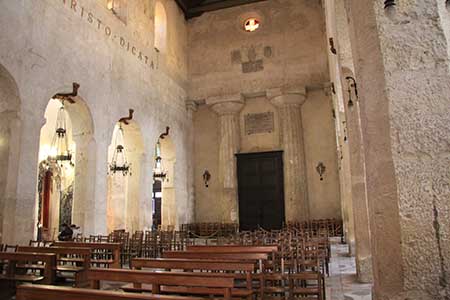 |
 |
The Cathedral of Syracuse in the Temple of Athena |
Stunning mosaics at Piazza Armerina |
We left Catania and headed south towards Syracuse passing through scenic coastal landscapes, stopping to see the ruins of the ancient city of Megara Hyblaea. This ancient Greek colony dates back to the 8th Century BC and then expanded in the Hellenistic Period. The walls of the city and its gates are well preserved, and an extensive area of houses has been exposed. We also stopped to see the ruins of Castello Euralio which lies perched on a prominent hill at the edge of the ancient walls of Syracuse. The fortress dates from around 400 BC and was built by Dionysius the Elder, tyrant of Syracuse. The central keep is particularly impressive and large sections of town wall are still standing. Upon arriving in Syracuse we checked into our hotel and went down to Ortygia Island, the ancient heart of the city. Here we went for a walk to see the ruins of the Temple of Apollo and also saw the Cathedral which is constructed inside the almost intact Temple of Athena, the ancient columns of the temple still visible in the walls. The Piazza Duomo in front of the Cathedral is particularly charming. We walked down to the Spring of Arethusa and around the old quarter which is particularly beautiful in the afternoon light.
The next morning we visited the Archaeological Museum of Syracuse. This is a very impressive museum with finds from across the island - the collection is huge and includes sculpture, vases and architectural elements. We then went for a walk in Syracuse and saw the ruins of the Church of St Giovanni built by the Normans around 1200. We later enjoyed a sundowner in Ortygia � a wonderful sunset over the bay and we enjoyed walking through the old city, making a visit to the Palazzo Bellomo, which has an impressive collection of Renaissance art.
On the 13th January we went to the Archaeological Park to the west of Syracuse. The Greek theatre, dating from the 5th Century, is particularly impressive, being carved from a local hillside. The cavea, or auditorium, has 42 rows of seats. Not far away we explored the Roman amphitheatre which was built in the 1st Century AD, and saw the ancient quarries of the city. We then drove up into the hills behind Syracuse to see the ruins of the ancient city of Akrai near the hill town of Palazzolo Acreide. This ancient colony of Syracuse includes a theatre and remains of ancient houses. Later in the day we took a drive to the Baroque hill town of Noto, rebuilt in grand style in 1702 after a major earthquake destroyed the earlier town.
Our trip next took us into the interior of the island of Sicily. We drove via the excellent motorway to the town of Aidone where we visited the small provincial museum. We went to the nearby archaeological site of Morgantina, a Greek and Roman city which preserves a civic centre with theatre and numerous houses with mosaics and wall frescoes. After lunch we drove to Piazza Armerina to see the incredible Villa Romana del Casale. This enormous residence of the late 3rd Century AD probably belonged to the Emperor Maximian and was his private retreat in a wooded and secluded site. The complex is decorated with 3,500 square m of mosaics, many of which bear comparison with the best mosaics in Tunisia�s Bardo Museum. The amount of labour involved is mind numbing and the result is truly wonderful � made even more enjoyable by the fact that we were literally the only tourists there and could take an inordinate number of photographs!
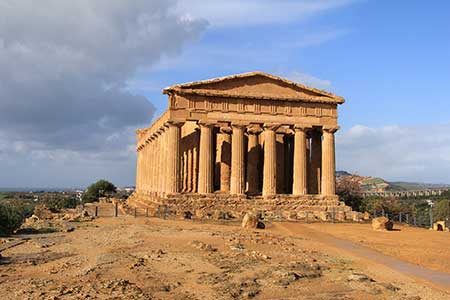 |
 |
The Temple of Concord at Agrigento |
Exploring Selinunte |
We spent that night in the hill town of Enna, almost exactly in the centre of Sicily. At 931 m above sea level the town was cool and misty and the hills around were covered with snow. This was an ancient city but the main sites to see today are the Castello di Lombardia and the tower of Frederick II which both date from the 13th Century. We also visited the gloomy Duomo (Cathedral). From Enna we drove down to Agrigento on the south coast, checking into the wonderful Villa Athena with its stunning views of the ancient site of Akragas � this is a very pleasant place to stay and we did not want to leave. We visited the ancient site, exploring the impressive Valley of the Temples. These include the incredibly well preserved 5th Century BC Doric temples dedicated to Concord and Hera, and the ruins of others dedicated to Heracles and Olympia Zeus. The local Archaeological Museum contains a stunning collection of artefacts including numerous works of sculpture and intact Greek vases from tombs. The colossi from the Temple of Zeus are also very impressive. The following morning we revisited the ruins of Akragas and were very reluctant to move on from this wonderful place.
On the 16th January we drove west along the coast of Sicily to the ancient site of Selinunte near the fishing village of Marinella. It was raining so we had a quiet afternoon and saw the site on the following day. This ancient city was founded in 651 BC and became increasingly prosperous. It was captured by the Carthaginians in 409 BC. The ancient settlement is well preserved and contains numerous Punic residences. The temple complexes are stunning and includes a number of reconstructed Doric shrines. The best preserved is Temple E which was probably dedicated to Hera - it is in a beautiful setting near the coast.
Our journey next took us westward along the coast of Sicily to Marsala. We had some lunch and then went to the Archaeological Museum which contains finds from both underwater excavations in the area particularly from the nearby Punic and Roman site of Lilybaeum. The remains of the Punic ships were interesting and we went for a walk through the ruins to see the remains of Roman houses with floor mosaics in situ. In the distance we could see the Aegetes Islands.
From Marsala we drove northwards to stay in Trapani for a few nights. We explored the old town, which is located on a peninsula at the NW corner of Sicily, including a number of churches (the 15th Century Cathedral) and baroque buildings. The following day we drove down to Motya, an island in a shallow bay south of Trapani. We took a ferry over to the island from an area surrounded by salt pans. Motya was an ancient Phoenician city (founded in the 8th Century BC) and the remains are unexpectedly impressive. They include the town walls, the ancient artificial harbour, a number of houses and the tophet, a cemetery which was probably used for the burial of sacrificed children. The on-site museum is very good and contains a huge collection of artefacts from the excavations, including the remains of Punic and Roman rostra (ships prows) from the First Punic War, household objects and numerous grave stones. In the afternoon we drove back northwards to Trapani. The next day we went to see the hill town of Erice which is perched on a spectacular hill near Trapani. The views from the Norman castle are spectacular. From here we headed east towards Palermo which would be our base of the next few days.
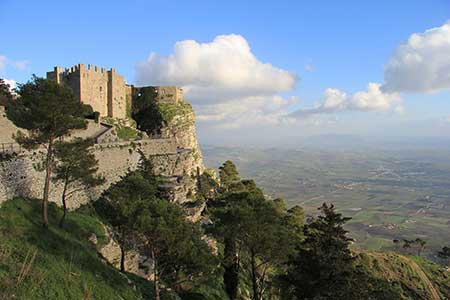 |
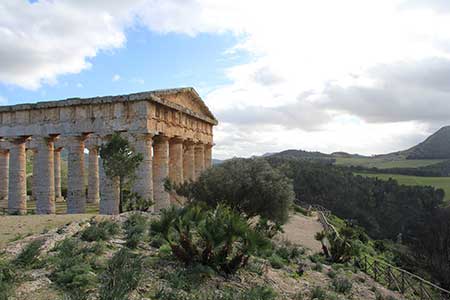 |
The hill town of Erice |
The temple at Segesta |
Palermo has a wonderful, historical centre with rich evidence from its Arab and Norman past. We went for a walk in the old quarter, stopping to see the elegant 12th Century Church of San Cataldo, a number of Baroque churches and the Norman Cathedral. The exterior is fascinating with its mix of styles and decorative elements inspired from Islam. Inside are the burials of some of the Norman kings. We then saw the Norman Palace of Palermo including the superb Palatine Chapel commissioned by Roger II of Sicily in 1132 � the chapel is covered with gold mosaics representing scenes from the Acts of the Apostles and has many elements of Arab origin as the craftsmen were of Arab heritage. Under the Castle are the remains of the Roman and Arab forts which previously existed here. We also saw the nearby 12th Century church of San Giovanni degli Eremiti which has very strong Arabic influences in its design.
The next morning we went to see the 12th Century palace of Zisa which was constructed by Arab workmen for Norman King William I and completed by his son William II. This was a summer residence for the Norman Kings inspired by Arab architecture - it has a wonderful fountain and loggia. From here we went to the Capuchin catacombs which have been used since the 16th Century � the monks use the limestone caverns to naturally mummify the dead and then suspend the bodies from the walls. Walking through the various chambers is a macabre experience as many of the mummies are astonishing well preserved. Others are entirely gruesome! We also visited the nearby palace of La Cuba, built by William II in 1180 as a pleasure resort in a great royal park. It has strong Fatimid influences as it was also built by Arab craftsmen. We then went down to the harbour area of Palermo and saw a number of churches. We also saw the prison which was used during the Inquisition in the 16th Century � the drawings on the cell walls of the various prisoners are fascinating.
One of the highlights of our trip to Sicily was a visit to Monreale, a hill town located behind Palermo. The Cathedral of Monreale and its associated monastery was created by the Normal King William II in 1174. The outside of the building is rather severe (except around the apse) while the interior contains what are probably the most extraordinary medieval mosaics anywhere. These were completed by Byzantine craftsmen - in the nave they show themes from the Old Testament from Creation to Noah and Abraham onwards, while the aisle mosaics show the teachings of Jesus including the feeding of the 5000. One scene shows William receiving his crown from Christ. William I and II are buried in the side chapels. Outside is the Benedictine monastery with its impressive cloisters, the arcades decorated under Arab influence and showing biblical themes carved into the column capitals.
From Palermo we drove eastwards to Solunto, an ancient Phoenician and Roman site located on a peninsula with spectacular views along the coast. The ruins included some impressive Roman houses with surviving sections of wall frescoes and some fine mosaics - the local museum was excellent with an informative display of Roman artefacts. From here we drove along the coast, stopping at the hill town of Caccamo to see the stunning castello, an enormous 12th Century castle dominating the landscape. After lunch we headed east again, heading for the town to Cefalu. Nestled under a dramatic rocky peninsula, the town is dominated by the 12th Norman Cathedral. The building was erected in 1131 by Roger II and although the exterior is very plain, the stunning mosaics inside, fashioned in Byzantine style with golden tesserae, show Christ Pantocrator in the central apse with the Madonna flanked by angels and the 12 apostles. In the late afternoon we drove further along the coast, stopping for the night in Milazzo.
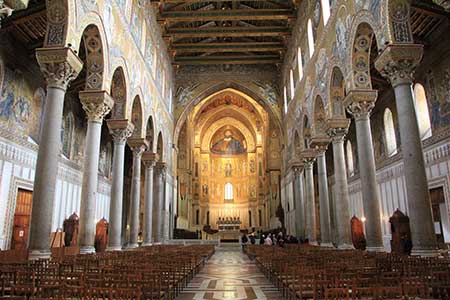 |
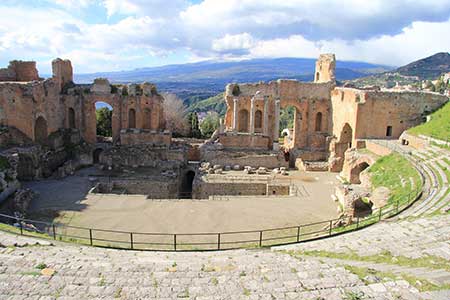 |
The Norman masterpiece at Monreale |
The theatre at Taormina |
Milazzo lies on another heavily defended peninsula along the north coast. In the morning of the 23rd January we drove up to see the castle which has views over to the Aeolian Islands. The castle was built by Frederick II in the 13th Century on the site of a Greek acropolis � the views are stunning. We then drove along the coast to visit the 4th Century ancient Roman villa of Patti Marina. This impressive structure was discovered by accident during the building of a viaduct and was found to preserve some interesting mosaics. The little site museum has an excellent collection of artefacts. We then drove to the ancient site of Tyndaris. This has been extensively excavated and on display are a Roman gateway into the agora, Roman baths and houses and a Hellenistic theatre. The natural setting adds to the grandeur of the place.
We drove along the east coast of Sicily with views of the Straits of Messina over to southern Italy, arriving in Taormina in the evening. Our hotel was in the centre of town and we enjoyed exploring the famous resort location (once we had found the hotel!). A highlight of Taormina, of course, was the stunning Roman theatre perched on the slope of the hill � it has magnificent views along the coast to Mt Etna and up the Straits of Messina. On the 25th January we drove around the foothills of Mt Etna to the small town of Randazzo, exploring some of the areas where the lava has come down the slope and destroyed houses. Being mid-Winter the summit was out of bounds but we enjoyed exploring some of the local scenery. We returned to Catania for our final night on Sicily before flying out to Rome the next day.
I had a week in Rome before the next tour to Egypt. I revisited many of my favourite places in the area including the Palazzo Massimo Museum near Termini Station and the ruins of the port city of Ostia. I also took the opportunity to walk a few km along the Via Appia � it was very beautiful in the early morning light.
Michael Birrell
